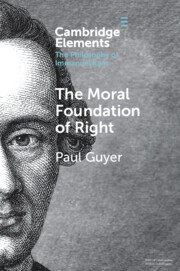Refine search
Actions for selected content:
133 results
First Collection
- from Letters for the Advancement of Humanity
-
- Book:
- Johann Gottfried Herder: Letters for the Advancement of Humanity
- Print publication:
- 22 January 2026, pp 3-57
-
- Chapter
- Export citation
Third Collection
- from Letters for the Advancement of Humanity
-
- Book:
- Johann Gottfried Herder: Letters for the Advancement of Humanity
- Print publication:
- 22 January 2026, pp 104-154
-
- Chapter
- Export citation

Johann Gottfried Herder: Letters for the Advancement of Humanity
-
- Expected online publication date:
- December 2025
- Print publication:
- 22 January 2026
Global politics of cultural heritage: Status, authority, and geopolitics
-
- Journal:
- Review of International Studies , First View
- Published online by Cambridge University Press:
- 11 November 2025, pp. 1-13
-
- Article
- Export citation
Truth, Justice, and the Human Way in James Gunn’s Superman
- Part of
-
- Journal:
- Public Humanities / Volume 1 / 2025
- Published online by Cambridge University Press:
- 07 November 2025, e156
-
- Article
-
- You have access
- Open access
- HTML
- Export citation
Chapter 6 - Expressing the Unnamable
- from Part I - Linguistic Implications of Kant’s Thought
-
-
- Book:
- Kant on Language
- Published online:
- 19 September 2025
- Print publication:
- 09 October 2025, pp 102-119
-
- Chapter
- Export citation
8 - The Idea of the Violin
- from Part II - The Conceptual Presence of Strings
-
- Book:
- Violin Culture in Britain, 1870–1930
- Published online:
- 13 September 2025
- Print publication:
- 18 September 2025, pp 219-261
-
- Chapter
- Export citation
1 - Scripture and Conciliar Teaching
- from Part I - Foundations and Statements of the Doctrine
-
- Book:
- The Humanity of Christ as Instrument of Salvation
- Published online:
- 21 August 2025
- Print publication:
- 04 September 2025, pp 15-30
-
- Chapter
- Export citation
Introduction
-
- Book:
- The Humanity of Christ as Instrument of Salvation
- Published online:
- 21 August 2025
- Print publication:
- 04 September 2025, pp 1-12
-
- Chapter
-
- You have access
- HTML
- Export citation
3 - St. Thomas Aquinas on the Instrument Doctrine
- from Part I - Foundations and Statements of the Doctrine
-
- Book:
- The Humanity of Christ as Instrument of Salvation
- Published online:
- 21 August 2025
- Print publication:
- 04 September 2025, pp 66-120
-
- Chapter
- Export citation
3 - Crimes against Humanity, Dehumanisation and Rehumanisation
-
- Book:
- Law and Inhumanity
- Published online:
- 20 June 2025
- Print publication:
- 17 July 2025, pp 45-66
-
- Chapter
- Export citation
Epilogue
-
- Book:
- Law and Inhumanity
- Published online:
- 20 June 2025
- Print publication:
- 17 July 2025, pp 121-125
-
- Chapter
- Export citation
Introduction
-
- Book:
- Law and Inhumanity
- Published online:
- 20 June 2025
- Print publication:
- 17 July 2025, pp 1-9
-
- Chapter
-
- You have access
- HTML
- Export citation
World heritage and inter/national cultural prestige
-
- Journal:
- Review of International Studies , First View
- Published online by Cambridge University Press:
- 07 July 2025, pp. 1-19
-
- Article
-
- You have access
- Open access
- HTML
- Export citation

Law and Inhumanity
- Dehumanization, Silent Claims and Atrocity Crimes
-
- Published online:
- 20 June 2025
- Print publication:
- 17 July 2025
10 - The Evolutionary Challenge and Where Each of Us Fits In
-
- Book:
- A Climate of Truth
- Published online:
- 27 March 2025
- Print publication:
- 27 March 2025, pp 212-233
-
- Chapter
- Export citation
Race, Culture, and the Horizons of Agency: Kant’s Racism, Systematically Understood
-
- Journal:
- Journal of the American Philosophical Association / Volume 11 / Issue 2 / June 2025
- Published online by Cambridge University Press:
- 20 January 2025, pp. 393-412
-
- Article
-
- You have access
- Open access
- HTML
- Export citation
3 - “Safe Third Country”
- from Part I - Territoriality and Rights Protection
-
-
- Book:
- Lawless Zones, Rightless Subjects
- Published online:
- 02 January 2025
- Print publication:
- 09 January 2025, pp 59-74
-
- Chapter
-
- You have access
- Open access
- HTML
- Export citation
8 - Capability Approach to Developing Global Health Initiatives for Equitable Access to Vaccines
- from Part II - Boosting Low-Income Countries’ Capacities for Protecting Public Health
-
-
- Book:
- Intellectual Property, COVID-19 and the Next Pandemic
- Published online:
- 17 December 2024
- Print publication:
- 05 December 2024, pp 217-240
-
- Chapter
-
- You have access
- Open access
- HTML
- Export citation

The Moral Foundation of Right
-
- Published online:
- 04 December 2024
- Print publication:
- 16 January 2025
-
- Element
- Export citation
